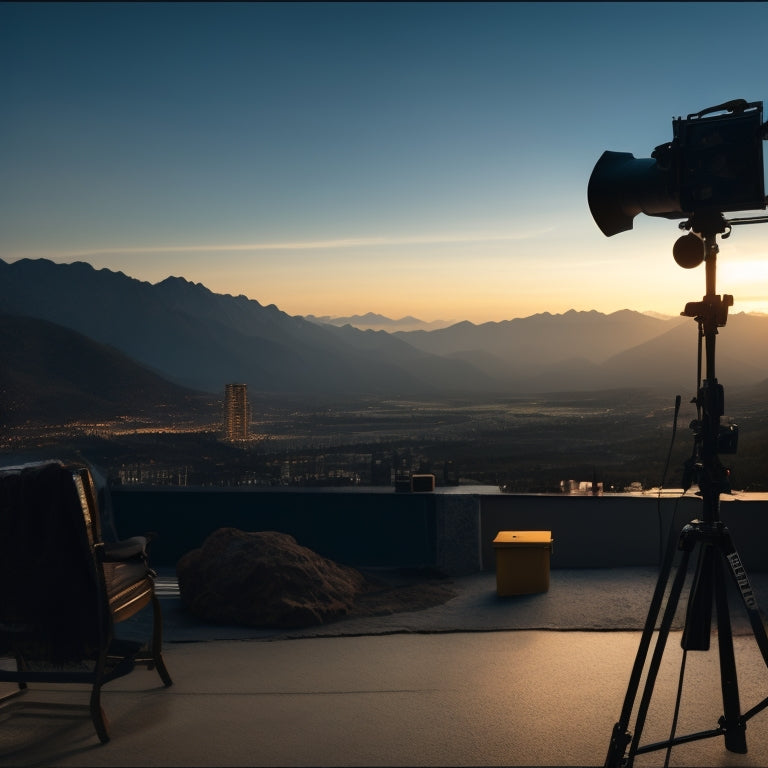
Ultimate Guide to Film Production Essentials
Share
Film production is a meticulous process that demands attention to detail, creative vision, and a thorough understanding of the essential elements that bring a story to life on screen. Successful film production involves mastering core principles such as pre-production planning, location scouting, and set design considerations. Essential tools and equipment like cameras, lighting gear, and editing software are also vital for capturing high-quality footage and refining the final product. Finally, post-production techniques like color grading, audio mixing, and visual effects integration elevate the narrative and create an immersive experience. By grasping these fundamentals, filmmakers can reveal the full potential of their creative vision.
Key Takeaways
• Mastering film production fundamentals, including pre-production planning and cinematography styles, is crucial for creating a cohesive visual narrative.
• Investing in essential tools and equipment, such as camera accessories and lighting gear, ensures high-quality footage and audio.
• Location scouting and set design considerations are vital for identifying the perfect setting and supporting the narrative.
• Post-production techniques, including color grading, audio mixing, and visual effects integration, refine the final product and evoke emotions.
• Editing software and techniques, such as pacing and shot selection, craft a compelling story and bring the filmmaker's vision to life.
Film Production Fundamentals
Understanding the core principles of film production is vital for creating a cohesive and engaging visual narrative, and it all begins with a solid grasp of the fundamentals.
Pre-production planning lays the groundwork for a successful shoot, involving meticulous preparation and organization. This phase includes pivotal tasks such as location scouting, where the perfect setting is identified to bring the story to life. Set design considerations also come into play, as the environment must be crafted to support the narrative.
Additionally, cinematography styles are considered, as the visual aesthetic of the film is established. By mastering these fundamental elements, filmmakers can craft a compelling story that resonates with audiences.
Essential Tools and Equipment
Effective film production relies on a well-curated arsenal of essential tools and equipment, carefully selected to bring creative vision to life. A solid foundation begins with camera accessories, such as lenses, tripods, and stabilizers, which ensure clear and stable footage.
Lighting gear, including LED panels, softboxes, and reflectors, helps create the desired mood and atmosphere. Additionally, sound recording equipment, such as microphones and audio recorders, captures high-quality audio.
Post-production requires editing software, like Adobe Premiere Pro or Final Cut Pro, to refine and polish the final product. By investing in these essential tools and equipment, filmmakers can confidently bring their creative vision to life, resulting in a professional and engaging final product.
Mastering Post-Production Techniques
With the foundation of essential tools and equipment firmly in place, the focus shifts to refining the captured footage through the art of post-processing, where the raw materials are transformed into a cohesive and engaging narrative. This is where the creative vision is refined, and the story is brought to life.
Key aspects of post-processing include:
-
Color grading: Enhancing the visual aesthetic to evoke emotions and set the tone.
-
Audio mixing: Balancing sound levels, adding FX, and creating an immersive experience.
-
Visual effects integration: Seamlessly incorporating CGI elements to elevate the narrative.
- Editing techniques: Crafting a compelling story through pacing, progressions, and shot selection.
Frequently Asked Questions
How Do I Protect My Work From Copyright Infringement?
To safeguard your creative work from copyright infringement, explore legal options such as registering with the U.S. Copyright Office and take precautions like watermarking, using non-disclosure agreements, and understanding intellectual property laws to guarantee prevention and protection of your original content.
Can I Use Royalty-Free Music in My Film?
When using royalty-free music in your film, consider creative alternatives like original scores or commissioning a composer. Explore licensing options, such as blanket licenses or per-track fees, to guarantee legal clearance and avoid copyright issues.
Do I Need a Film Permit for Public Location Shooting?
When filming on public locations, obtaining a permit is essential to avoid legal implications and consequences. Understand the permit process and requirements to guarantee compliance, as failure to obtain necessary permits can result in fines, confiscation of equipment, and even criminal charges.
How Do I Get My Film Into Film Festivals?
'Pursuing esteemed debuts, filmmakers must carefully craft all-encompassing film festival submissions, considering sought-after categories, complying with content criteria, and committing to costly submission fees, all essential components of a calculated campaign for cinematic success.'
What's the Best Way to Market My Film on Social Media?
To effectively market your film on social media, leverage influencer collaborations and viral campaigns to generate buzz. Implement targeted ads and engaging content strategies to reach your target audience and drive ticket sales.
Related Posts
-

7 Downloadable Dance Makeup Tutorials for Men
You're about to access a world of bold, edgy, and mesmerizing dance makeup looks with these 7 downloadable tutorials ...
-

What Are the Essential Performance Clothing Items for Your Next Workout
When it comes to crushing your next workout, the right performance clothing can make all the difference. You'll want ...
-

Dance Audition Essentials: Must-Haves for Success
You're about to take your dance audition to the next level by focusing on the essentials that'll give you an edge. St...


